A phenol-enriched cuticle is ancestral to lignin evolution in land plants
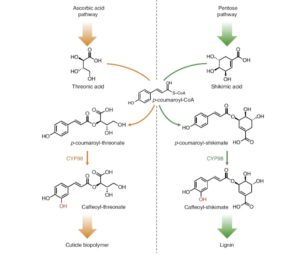 Moss are non-vascular plants and do not produce the phenolic polymer lignin, but they do have some enzymes associated with the lignin pathway, raising the question of the evolutionary origins of lignin. In angiosperms, the cytochrome P450 enzyme encoded by CYP98 catalyzes the first irreversible step in monolignol (a lignin subunit) formation. Renault et al. showed that the moss CYP98 gene is critical for cuticle formation, an extracellular polymer required for desiccation tolerance. This result suggests that the “lipid–phenolic matrix present in P. patens may constitute an extant representative of the common ancestor of the suberin, cutin and lignin polymers” that was presumably critical for the transition of plants to land. Nature Comm. 10.1038/ncomms14713
Moss are non-vascular plants and do not produce the phenolic polymer lignin, but they do have some enzymes associated with the lignin pathway, raising the question of the evolutionary origins of lignin. In angiosperms, the cytochrome P450 enzyme encoded by CYP98 catalyzes the first irreversible step in monolignol (a lignin subunit) formation. Renault et al. showed that the moss CYP98 gene is critical for cuticle formation, an extracellular polymer required for desiccation tolerance. This result suggests that the “lipid–phenolic matrix present in P. patens may constitute an extant representative of the common ancestor of the suberin, cutin and lignin polymers” that was presumably critical for the transition of plants to land. Nature Comm. 10.1038/ncomms14713


 The patterning of stomata in epidermal tissues involves both positive and negative cues, as revealed by the phenotypes of mutants including too many mouths and speechless, but the precise interactions between identified gene products are still not fully resolved. Qi et al. explore the interactions between SPEECHLESS (SPCH) and MUTE, transcription factors, EPIDERMAL PATTERNING FACTOR2 (EPF2), a small secreted peptide, and a set of membrane receptors including TOO MANY MOUTHS (TMM), EPIDERMAL PATTERNING FACTOR1 (EPF1) and EPF2, and ERECTA and ERECTA-LIKE1 (ERL1). Key findings include that ERL1 is a MUTE-induced gene, and that EPF1-ERL1 signaling pathway inhibits MUTE. The authors propose a model in which the co-presence of EPF1, ERL1, and MUTE inhibits stomatal fate, and argue that EPF1 acts as an autocrine signal. eLIFE
The patterning of stomata in epidermal tissues involves both positive and negative cues, as revealed by the phenotypes of mutants including too many mouths and speechless, but the precise interactions between identified gene products are still not fully resolved. Qi et al. explore the interactions between SPEECHLESS (SPCH) and MUTE, transcription factors, EPIDERMAL PATTERNING FACTOR2 (EPF2), a small secreted peptide, and a set of membrane receptors including TOO MANY MOUTHS (TMM), EPIDERMAL PATTERNING FACTOR1 (EPF1) and EPF2, and ERECTA and ERECTA-LIKE1 (ERL1). Key findings include that ERL1 is a MUTE-induced gene, and that EPF1-ERL1 signaling pathway inhibits MUTE. The authors propose a model in which the co-presence of EPF1, ERL1, and MUTE inhibits stomatal fate, and argue that EPF1 acts as an autocrine signal. eLIFE  Rice is the world’s most important food crop and its domestication was a key event in human history. Centuries of propagation across large geographical areas have resulted in five domesticated subpopulations: aus, indica, temperate japonica, tropical japonica, and aromatic rice. Choi et al. analyzed de novo assembled genomes from domesticated rice and its wild progenitors. Their analysis indicates that although different rice subspecies had different origins, domestication occurred only once. Introgression of domestication genes from japonica to aus and indica led to their domestication, which is consistent with archeological evidence. Mol. Evol.
Rice is the world’s most important food crop and its domestication was a key event in human history. Centuries of propagation across large geographical areas have resulted in five domesticated subpopulations: aus, indica, temperate japonica, tropical japonica, and aromatic rice. Choi et al. analyzed de novo assembled genomes from domesticated rice and its wild progenitors. Their analysis indicates that although different rice subspecies had different origins, domestication occurred only once. Introgression of domestication genes from japonica to aus and indica led to their domestication, which is consistent with archeological evidence. Mol. Evol. 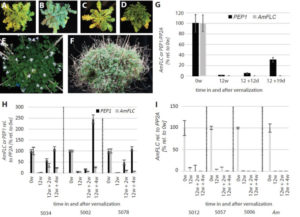 FLOWERING LOCUS C (FLC) is a flowering repressor that is highly conserved in the Brassicaceae family. This family contains species that show an annual life history (plants that flower and senesce, giving one generation per year), as well as perennials (plants that flower several times in their life cycle and don’t senesce after producing the next generation). Kiefer et al. studied the divergence of annuals and perennials in this family. They confirmed perenniality is the ancestral state with annuality evolving independently in several lineages. They found several FLC orthologues in the species they studied but no correlation between the complexity of those orthologues (gene and intron duplication, deletions or insertions) and life history. However, they show that the FLC orthologues set a vernalization requirement in almost all the species that were studied (except in one, Arabis purpurea). Moreover, expression of the FLC orthologues also corresponds with the expected pattern before, during and after vernalization in annuals and perennials. The genetic basis of this difference is analyzed in hybrids and sequence variation and the authors show that two regions with variation might be responsible to confer stable repression or reactivation of FLC after vernalization in annuals and perennials respectively. (Summary by
FLOWERING LOCUS C (FLC) is a flowering repressor that is highly conserved in the Brassicaceae family. This family contains species that show an annual life history (plants that flower and senesce, giving one generation per year), as well as perennials (plants that flower several times in their life cycle and don’t senesce after producing the next generation). Kiefer et al. studied the divergence of annuals and perennials in this family. They confirmed perenniality is the ancestral state with annuality evolving independently in several lineages. They found several FLC orthologues in the species they studied but no correlation between the complexity of those orthologues (gene and intron duplication, deletions or insertions) and life history. However, they show that the FLC orthologues set a vernalization requirement in almost all the species that were studied (except in one, Arabis purpurea). Moreover, expression of the FLC orthologues also corresponds with the expected pattern before, during and after vernalization in annuals and perennials. The genetic basis of this difference is analyzed in hybrids and sequence variation and the authors show that two regions with variation might be responsible to confer stable repression or reactivation of FLC after vernalization in annuals and perennials respectively. (Summary by 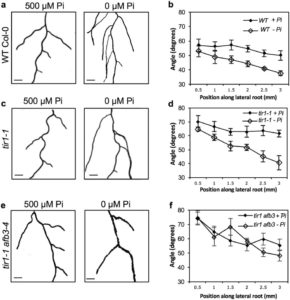 One parameter that defines a plant’s architecture is the angle at which its branches and lateral roots lie with respect to gravity, known as the gravitropic set point angle (GSA). Like all aspects of plant architecture, GSA is a highly plastic trait that is sensitive to light and nutrient availability. Roychoudhry et al. show that these effects on GSA are mediated by auxin levels or sensitivity. Key findings include opposite effects of low N and low P on lateral root GSA, and differences in the way that adventitious roots and lateral roots respond to nutrient deficiencies. Sci. Rep.
One parameter that defines a plant’s architecture is the angle at which its branches and lateral roots lie with respect to gravity, known as the gravitropic set point angle (GSA). Like all aspects of plant architecture, GSA is a highly plastic trait that is sensitive to light and nutrient availability. Roychoudhry et al. show that these effects on GSA are mediated by auxin levels or sensitivity. Key findings include opposite effects of low N and low P on lateral root GSA, and differences in the way that adventitious roots and lateral roots respond to nutrient deficiencies. Sci. Rep. 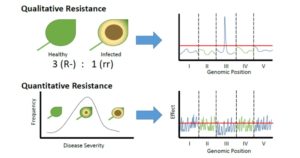 Some forms of pathogen resistance function like an on/off switch: if a plant has an appropriate receptor it recognizes a pathogen and shows resistance. Corwin and Kliebenstein review the other kind of resistance, quantitative resistance, in which many genes make small contributions to the plant’s resistance. These quantitative resistance loci are lesser known and more difficult to study, but nevertheless govern the outcome of the majority of plant-pathogen interactions. The authors review some of the molecular players involved in quantitative resitance and also describe the genetic and genomic tools that are helping to shed light on the mechanisms of quantitative resistance. Plant Cell
Some forms of pathogen resistance function like an on/off switch: if a plant has an appropriate receptor it recognizes a pathogen and shows resistance. Corwin and Kliebenstein review the other kind of resistance, quantitative resistance, in which many genes make small contributions to the plant’s resistance. These quantitative resistance loci are lesser known and more difficult to study, but nevertheless govern the outcome of the majority of plant-pathogen interactions. The authors review some of the molecular players involved in quantitative resitance and also describe the genetic and genomic tools that are helping to shed light on the mechanisms of quantitative resistance. Plant Cell  Zhou et al. review the contributions of Receptor-Like Kinases (RLKs) and Receptor-Like Proteins (RLPs) as Pattern Recognition Receptors (PRRs) that contribute to the recognition of pathogens, as well as the contributions of receptor-like cytoplasmic kinases (RLCKs). The authors summarize recent studies that show how complex formation by PRRs affects their activities, and how PRR complexes and RLCKs differentially regulate downstream signals. Finally, the authors summarize the many ways that pathogens subvert the recognition and elicitation of defense responses. Plant Cell
Zhou et al. review the contributions of Receptor-Like Kinases (RLKs) and Receptor-Like Proteins (RLPs) as Pattern Recognition Receptors (PRRs) that contribute to the recognition of pathogens, as well as the contributions of receptor-like cytoplasmic kinases (RLCKs). The authors summarize recent studies that show how complex formation by PRRs affects their activities, and how PRR complexes and RLCKs differentially regulate downstream signals. Finally, the authors summarize the many ways that pathogens subvert the recognition and elicitation of defense responses. Plant Cell 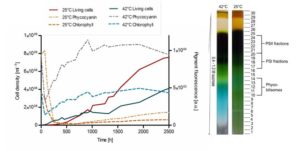
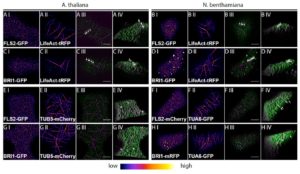 Signal transduction in plant and animal cells is often initiated at the plasma membrane (PM) and involves common signaling components, raising the question of how receptor complexes elicit distinct signaling outputs. To address this question,
Signal transduction in plant and animal cells is often initiated at the plasma membrane (PM) and involves common signaling components, raising the question of how receptor complexes elicit distinct signaling outputs. To address this question,